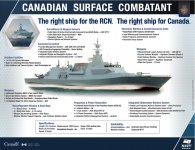Maxman1
Army.ca Veteran
- Reaction score
- 1,770
- Points
- 1,160
It also requires that the elevators and hangers can handle the aircraft, for the F35b , the Mistrals not be my first choice, I would go with a vessel based on the San Juan 1/Canberra Class giving some aviation and amphibious benefits as well. However to fit into our current budget and crewing realities, the Mistrals with helicopters are a far better fit for Canada. I would give up a AOP's and a CSC for them.
Now that I think about it, could a Mistral handle a CT-156 Harvard II (and is a Harvard II carrier-capable)? Because there's a light attack version of it, the AT-6 Wolverine, which has been adopted by the USAF. If we could operate those from a Mistral, that would be pretty slick.









